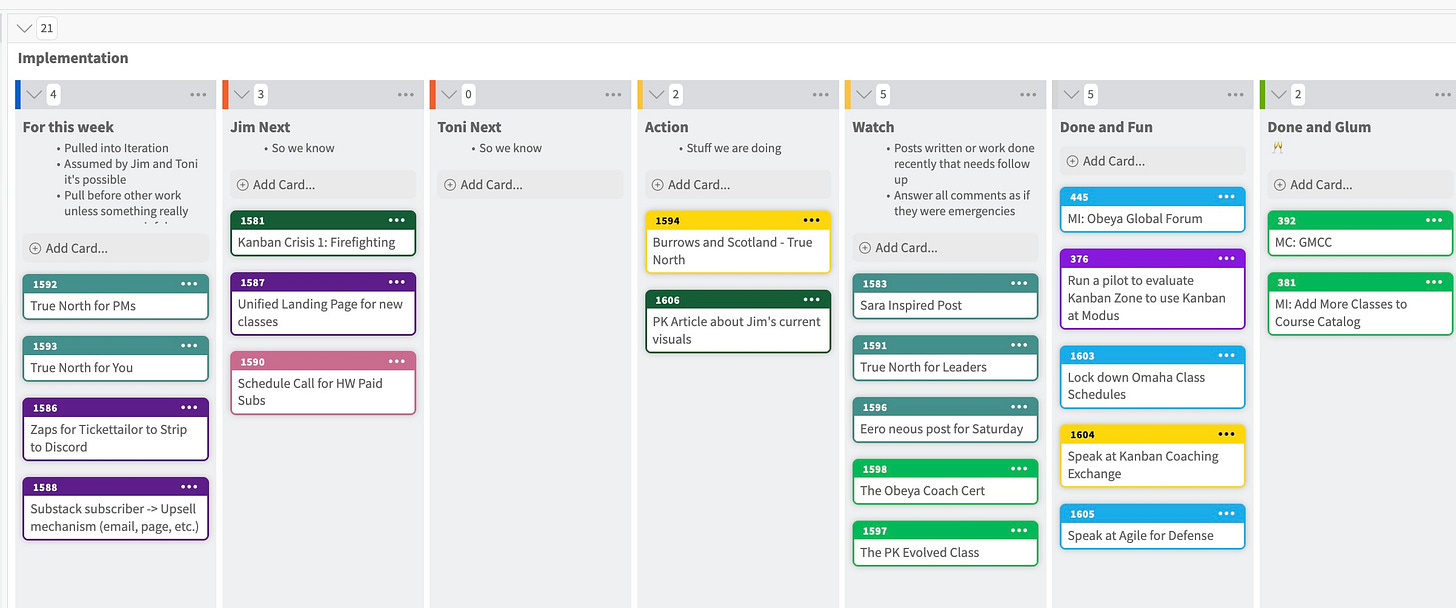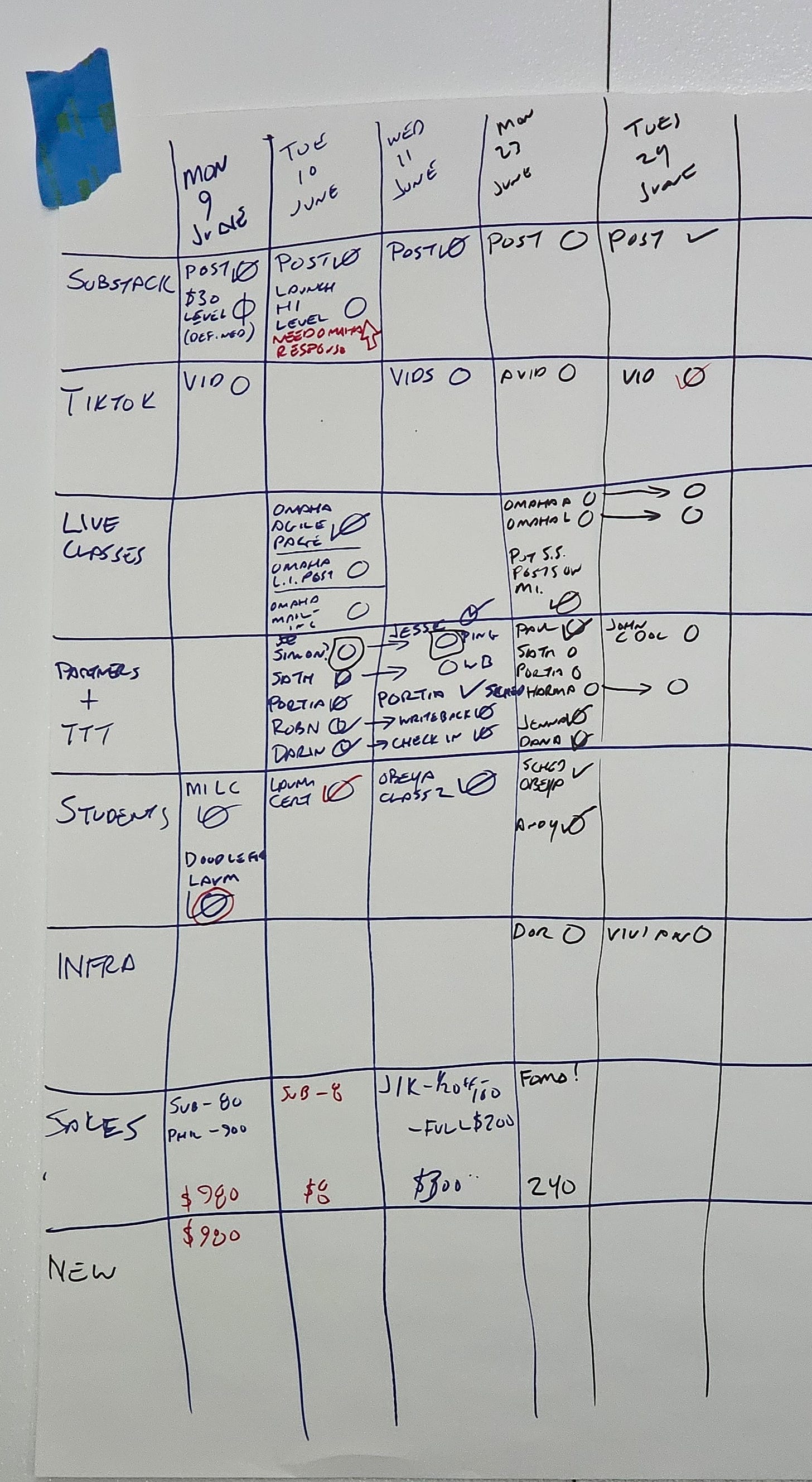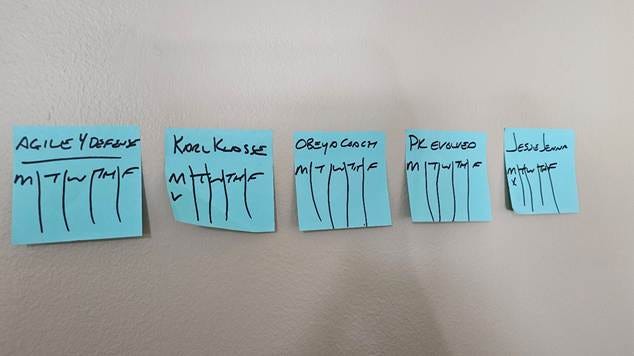“I work in construction. Nothing is going to impact my work/life balance. But the Kanban here in this room helps me communicate with my bosses, their bosses, and my team. They know what’s going on and that helps me act with confidence.”
Those words (or close enough) were said by Kevin Chase at Turner Construction several years ago, when people asked him if his Obeya let him get work done faster and, therefore, go home earlier.
I have a lot of work to do at Modus. It just goes with the territory. You have a lot of work to do as well.
and I have a Personal Kanban in KanbanZone that is very buttoned down. (Below) It is central to our work, but not the only visualization in our quiver. The fact is, even if the tasks show up in the PK, they aren’t always in the right context.The sticky notes on my wall tell a story that goes far beyond the basic "To Do, Doing, Done" columns you see in most Personal Kanban. What you're looking at isn't a deviation from Personal Kanban—it's Personal Kanban evolved for the complex reality of professional life.
The two boards I’m going to show now visualize something that gets lost when we talk about productivity systems: real work doesn't fit into neat categories, and real professionals juggle multiple streams of commitment that require different types of attention at different rhythms.
Let me explain why these alternative approaches matter when you are trying to visualize your work… without losing your mind.
The Multi-Stream Commitment Board: Flexible Leader Standard Work
I started using This “Commitment Board” during covid when we had several clients and Modus Institute was literally overwhelmed with new students.
The Initial Problem to Solve: I was constantly making micro-promises to people in meetings (I’ll get you this, I’ll get you that) and, even with the best of stickynoting, I was losing them all the time. Overloaded, things were being overlooked.
How it works: The commitment board uses swim lanes to track different types of professional commitments. In this image there is substack content, live classes, partner collaborations, and more. The swim lanes change with the needs at the time. For example, when we had Crown Equipment as a client, there was a dedicated Crown lane. Each swim lane represents a different stream of responsibility that needs attention over the course of several days or weeks.
This isn't about managing daily tasks as a pile of ToDos. This ensures that over time, I'm paying appropriate attention to all the areas that matter without over-focusing on any single stream and accidentally dropping balls in others.
It is about allowing me to act with confidence by achieving some degree of balance.
Why this works: We create Personal Kanbans to gain control of the real work we have on our plate. The first rule is to visualize work, the basic structure of Personal Kanban is just that, it’s basic. When we are an experienced Personal Kanban practitioner, we assume our workflows will never be at the same pace and requires the same type of attention.
Content creation might happen in bursts, partner relationships need consistent but light touch points, and live classes require intensive preparation followed by delivery and follow-up. The swim lane approach lets me see these different rhythms visually and ensure I'm maintaining continuity across all of them.
This is what we call "flexible leader standard work". There is a discipline in ensuring important areas get attention without the rigidity of checklists or the chaos (and disappointment) of hoping you'll remember everything. This directly responded to my reality that the nature of my work changes from day to day. One day content creation might be a video, another day an article, another day an interview. Some days I’m making the content, sometimes I’m just part of an interview panel. In either case, when it’s released, I need to let my network know that new the resource is available to them.
The work type varies, but the commitment to the stream remains consistent.
The Continuity Commitment Board: Maintaining Human Connections
The five sticky notes show my commitment to five courses currently in development at Modus Institute. Each involves different collaborators, and each requires me to provide ongoing support and continuity to keep the partnerships healthy and productive. In some I am the major actor, in others I’m a supporting role, in all I am committed.
The Initial Problem to Solve: All of these courses (you should sign up for them) are awesome. All of them require daily touch. If I do not provide that touch, my colleagues will feel (rightly) like they are not a priority. There are five of them. That’s a lot to handle each week and they are all impending. Each of these classes happens in a few weeks.
How this Works: This simple board ensures that each day, I provide some form of support to the people I'm working with. Some days it's a check-in, some days it's creating new content, some days it's planning sessions. The specific action varies, but the commitment to maintaining connection and momentum remains constant.
Why this matters: Collaborations fail when continuity breaks down. When partners stop feeling supported or connected to the work, that's when relationships deteriorate and projects stall. This simple visual system prevents me from accidentally neglecting any collaboration while avoiding the overhead of complex project management systems. Making sure our collaborators are cared for is probably the single most difficult thing we do. Visualize it and make sure it happens.
*Right now Toni and I are juggling a lot of balls, we both feel very under-the-gun and under-supported. I know this happens to you as well, when this situation is in process this will help, but you, personally, still need to be there. The post it notes are telling you to do the work, they aren’t actually the work.
Beyond the Basic Columns: Visualizing Capacity (Sanity), Not Just Tasks
Both of these boards visualize something fundamental that gets lost in basic Personal Kanban, Kanban, Lean, and Agile instruction. These boards are visualizing capacity and commitment, not just task completion. We are interested in more than productivity or doing twice as much in half the time or whatever.
Throughput without satisfaction is empty calories.
CTA: Making Your Own Alternative Personal Kanban
These alternative approaches are part of what we explore in the Personal Kanban Evolved workshop series. Over 20 years of watching people implement Personal Kanban, we've discovered that the most successful practitioners don't stick rigidly to basic columns, they adapt the visualization to match how their work actually flows.
The goal is sustainable effectiveness. It's creating visual systems that help you see your work clearly enough to make good decisions about what to focus on, what to delegate, and what to decline.
If you're ready to move beyond basic task management and explore how Personal Kanban can adapt to your complex professional reality, join us for Personal Kanban Evolved: 4 Workshops in August. We'll explore these alternative approaches and many more patterns that emerge when you've been visualizing work long enough to see what really matters.




